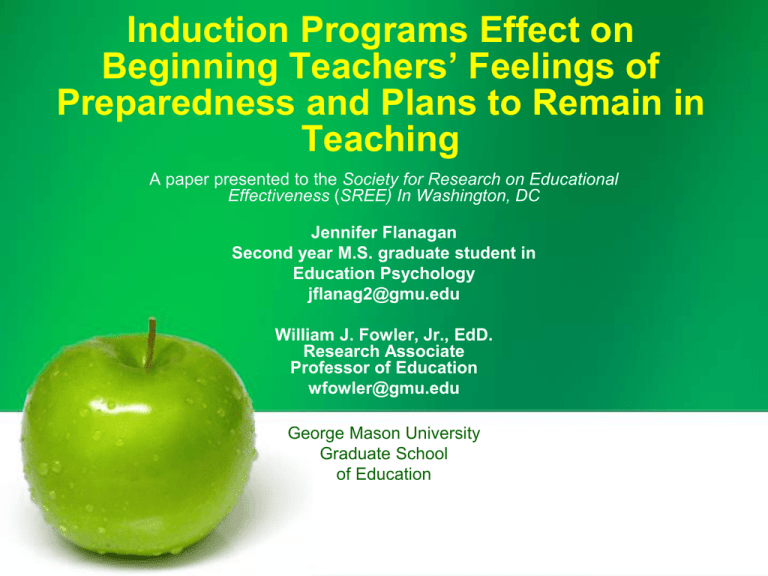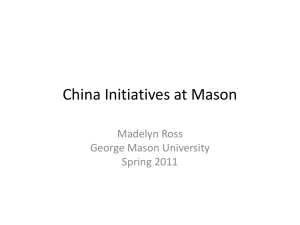Induction Programs Effect on Beginning Teachers* Feelings
advertisement

Induction Programs Effect on Beginning Teachers’ Feelings of Preparedness and Plans to Remain in Teaching A paper presented to the Society for Research on Educational Effectiveness (SREE) In Washington, DC Jennifer Flanagan Second year M.S. graduate student in Education Psychology jflanag2@gmu.edu William J. Fowler, Jr., EdD. Research Associate Professor of Education wfowler@gmu.edu George Mason University Graduate School of Education Objectives Possible relationships between induction programs and beginning teachers’ Feelings of preparedness • Plans to continue teaching Replicate of the previous work of Smith and Ingersoll (2004) (that used the 1999-2000 SASS) with the 20072008 SASS • • Our hypothesis: • More elaborate induction programs will be associated with a higher percentage of teachers that plan to remain in teaching as well as greater feelings of preparedness. George Mason University 2 Theoretical Framework Beginning Teacher Induction Programs • • • Put in place in public schools across the nation because of the challenges new teachers face in the classroom and to mitigate beginning teacher attrition. Aim to offer support, guidance, and orientation for the newcomers, but are significantly varied across school systems (Smith & Ingersoll, 2004). The more comprehensive induction programs have previously showed the lowest turnover percentage, but were not commonly offered (Smith & Ingersoll, 2004). George Mason University 3 Theoretical Framework Approximately 50% of teachers leave the profession within the first five years of teaching (Smith & Ingersoll, 2004). Voluntary more then involuntary (Guarino, Stanibañez, and Daley, 2006) The teacher reported reasons for leaving the profession or seeking out new positions within the field include • • • insufficient administrative support lack of student motivation unsatisfactory salary and benefits (Smith & Ingersoll, 2004). George Mason University 4 Theoretical Framework A shift in emphasis on the importance of retaining quality teachers, rather than focusing on recruiting (Guarino et al., 2006, Kersaint, Lewis, Potter, and Meisels, 2007) . George Mason University 5 Theoretical Framework Glazerman’s et al. (2008) randomized control study of a comprehensive teacher induction program had no effect on teacher retention after one year or even after a second year. They also believed teacher preparedness was a mediating factor for teacher retention, however, they found that comprehensive teacher induction made teachers feel neither more satisfied with or better prepared for their jobs as teachers. George Mason University 6 Theoretical Framework Using the NCES Schools and Staffing 2007-2008 restricted individual teacher dataset: We seek to confirm Smith and Ingersoll’s findings from the 2000 SASS, and to inform these conflicting findings from the Glazerman’s et al. study and Isenberg’s et al. randomized control studies. We attempt to capture the intensity of induction supports, although we leave to the more ambitious randomized control studies the question of whether the inferences we draw are causal. George Mason University 7 Research Questions Are beginning teachers feeling more prepared to teach having participated in an induction program during their first year of teaching? Does a more elaborate induction program lead to higher feelings of preparedness in beginning teachers? Are plans to continue teaching and participation in an induction program related for beginning teachers? What support is being offered to beginning teachers in their first year of teaching? Which supports are highly correlated with plans to remain in teaching? George Mason University 8 Methods Population • • Restricted data from the 47,440 nationally and state representative sample (weighted n = 305,306) beginning public school teachers (SASS, 2007). Beginning Teachers- 3 years or less of teaching experience Analysis • • SPSS, AM, and STATA statistical software programs EDA, t-tests, chi-squared tests of association, factor analysis, OLS and multinomial logistic regressions George Mason University 9 Methods Created variables: • Feelings of preparedness • Factor Analysis • • • • • Handle a range of classroom management or discipline situations Use a variety of instructional methods Assess students Select and adapt curriculum and instructional materials Plans to remain in teaching • • • Recoded to a scale of 1-7 “As long as I am able” was coded as a seven “Definitely plan to leave as soon as I can” was coded as a one George Mason University 10 Means and Standard Deviations and Factor Loadings for Items of Preparedness Scale M SD Factor loading T0214 Handle a range of classroom management or discipline situations? 2.73 0.817 0.551 T0215 Use a variety of instructional methods? 2.95 0.783 0.696 T0218 Assess students? 2.91 0.734 0.672 T0219 Select and adapt curriculum and instructional materials? 2.83 0.799 0.673 Scale number Item Note. Numbers beside items refer to the variable in the Schools and Staffing Survey data set. George Mason University 11 Methods Induction Program Supports • • • • • • Common planning time with other teachers Extra classroom assistance (i.e. teacher aides) Classes or seminars for beginning teachers Ongoing guidance from a master or mentor teacher Support from principal and administration Reduced teaching schedule or number of preparations (SASS, 2007) George Mason University 12 Outcomes Beginning Teachers’ Feelings of Preparedness Level of Preparedness Level of Preparedness Level of Preparedness First Year Teaching with Induction Program M(SD) First Year Teaching without Induction Program M(SD) 2.87 (.63) 2.76 (.66) Induction Programs with at Least Four Supports Provided M(SD) Induction Programs with No Supports Provided M(SD) 2.91 (.62)* 2.56 (.73)* Induction Programs with at All Six Supports Provided M(SD) Induction Programs with Less than Three Supports Provided M(SD) 3.06 (.62)* 2.81 (.64)* Note. * = p < .05. George Mason University 13 Outcomes Beginning Teachers’ Plans to Remain in Teaching Definitely plan to leave as soon as I can 1% 6% Until a more desirable job opportunity comes along 7% Until a specific life event occurs 18% 56% Undecided at this time Until I am eligible for Social Security benefits <1% 12% Until I am eligible for retirement benefits from this job/a previous job As long as I am able George Mason University 14 Outcomes Those teachers who reported participating in an induction program were more likely than those who did not participate to state that they would remain in teaching “as long as they were able” (t(88) = -13.317, p < .000*). There was no significant difference between those teachers who wanted to “leave teaching as soon as possible”, whether they reported having participated in an induction program or not (t(88) = -0.421, p = .675) (SASS, 2007). George Mason University 15 Outcomes 75% of beginning teachers reported having participated in an induction program during their first year of teaching Frequency of Induction Program Supports 90% 80% 70% 79% 78% 68% 60% 45% 50% 40% 26% 30% 20% 12% 10% 0% Supportive Guidance Seminars administrationfrom a mentor Common Extra planning time classroom help George Mason University Reduced schedule 16 Multinomial Logistic Regression Analysis of Beginning Teachers' Plans to Remain in Teaching George Mason University 17 Multinomial Logistic Regression Analysis of Beginning Teachers' Plans to Remain in Teaching George Mason University 18 Outcomes Elaboration of Induction Programs Model 1 (Teacher and School Characteristics) • • Age (rrr = .917, p =.005)* Minority status (rrr = 1.016, p = .006)*. Model 2 (Mentor) • 56% reduced risk of leaving • (rrr = .442, p = .025)*. Model 3 & 4 (Seminars & Common Planning Time) • • (rrr = .575, p =.120) 42% reduced risk • (rrr = .443, p =.031)* George Mason University 19 Outcomes Level of Elaboration for Induction Programs Model 5 (Supportive administration) • 79% reduced risk of leaving • (rrr = .205, p <. 000)* Model 6 (Reduced schedule) (rrr = .362, p =.167) Model 7 (Extra classroom help) • (rrr = .480, p =.107)* Model 8 (All) • • Supportive administration • 73% reduced risk of leaving (rrr = 0.273, p = 0.001)* George Mason University 20 Outcomes Elaboration of Induction Programs Two supports (Administration and Mentor) over four times as likely to remain in teaching with this induction program elaboration (e^b = 4.38, p < .000)*. Four supports (Above plus Common planning time and Seminars) • just under four times as likely to remain in teaching (e^b = 3.91, p < .000)*. Six supports (Above plus Reduced teacher schedule and Extra classroom help) • • • under four times more likely to remain teaching (e^b = 3.67, p = .001)*. George Mason University 21 Educational Significance Beginning teachers are reporting feeling least prepared to discipline and assess students, as well as select instructional materials. Controlling for teacher and school characteristics having a induction program with • • • a mentor teacher reduces the risk of leaving by 56%. a common planning time with another teacher reduced the risk of leaving by 42%. a supportive administration reduced the risk of leaving by 79%. Having an induction program with a supportive administration and all other induction program supports, while controlling for teacher and school characteristics, reduced risk of leaving teaching by 73%. George Mason University 22 Educational Significance Various combinations of program supports demonstrating elaborations of the induction programs resulted in a beginning teacher being around four times more likely to remain in teaching. George Mason University 23 Conclusions Despite the Glazerman et al. (2008) and Isenberg’s et al. (2009) studies that found no significant difference between teacher attrition rates and teachers’ feeling of preparedness after participating in an elaborate induction program, our findings suggest otherwise. These studies have also found no significant difference between teacher attrition rates and teachers’ participation in an elaborate induction program, where as our findings suggest that a beginning teacher would be much more likely to remain in teaching. George Mason University 24 Conclusions Forgive us if we wonder if some aspect (the sample; the cluster random assignment of eligible teachers; HLM) of such a sophisticated study resulted in findings that differ from those of SASS. George Mason University 25 Recommendation for Future Study We would propose that future “gold standard” studies determine if any of the school districts or schools or teachers studied are also in the 200708 Schools and Staffing Survey (SASS) or the 2008-2009 Teacher Follow-up Survey (TFS), and that the comparison of results between these federal statistics and the more sophisticated and ambitious studies might be instructive. George Mason University 26 References Annotated SPSS Output: Principal Components Analysis. (n.d.). . Retrieved February 1, 2010, from http://www.ats.ucla.edu/stat/SPSS/ output/principal_components.htm Astin, A. W.& Denson, N. (June, 2009). Multi-Campus Studies of College Impact: Which Statistical Method Is Appropriate? Research in Higher Education, v50 n4 p354-367 Jun 2009. Borman, G., & Dowling, N. (2008). Teacher Attrition and Retention: A MetaAnalytic and Narrative Review of the Research. Review of Educational Research, 78(3), 367-409. Retrieved April 3, 2009, from Education Research Complete database. Brill, S., & McCartney, A. (2008). Stopping the revolving door: increasing teacher retention. Politics & Policy, 36(5), 750-774. Retrieved June 14, 2009, doi:10.1111/j.1747-1346.2008.00133.x Coalition for EvidenceBased Policy. (2007). When Is It Possible to Conduct a Randomized Controlled Trial in Education at Reduced Cost, Using Existing Data Sources? A Brief Overview. Coalition for Evidence-Based Policy, Washington, DC. Retrieved February 25, 2010, from http://www.eric.ed.gov/ERICWebPortal/custom/portlets/recordDetails/ detailmini.jsp?_nfpb=true&_&ERICExtSearch_SearchValue_0=ED506628 &ERICExtSearch_SearchType_0=no&accno=ED506628 George Mason University 27 References Coopersmith, J., & Gruber, K. J. (2009). Characteristics of Public, Private, and Bureau of Indian Education Elementary and Secondary School Teachers in the United States: Results from the 2007-08 Schools and Staffing Survey. Department of Education, National Center for Education Statistics. Retrieved from http://nces.ed.gov/pubsearch/pubsinfo.asp?pubid=2009324 Field, A. (2005). Discovering Statistics Using SPSS (2nd ed.). Sage Publications Ltd. Glazerman S., Dolfin, S., Bleeker, M., Johnson, A., Isenberg, E., Lugo-Gil, J., Grider, M. and Britton, E. (2008). Impacts of Comprehensive Teacher Induction: Results From the First Year of a Randomized Controlled Study (NCEE 2009-4034). Washington, DC: National Center for Education Evaluation and Regional Assistance, Institute of Education Sciences, U.S. Department of Education. Guarino, C., Santibañez, L., & Daley, G. (2006). Teacher Recruitment and Retention: A Review of the Recent Empirical Literature. Review of Educational Research, 76(2), 173-208. Retrieved April 4, 2009, doi:10.3102/00346543076002173 Hayes, W. (1988). Statistics (4th ed.). New York: Holt, Rinehart, & Winston. George Mason University 28 References Ingersoll, R. (2001). Teacher turnover and teacher shortages: An organizational analysis. American Educational Research Journal, 38(3), 499-534. Retrieved April 20, 2009, doi:10.3102/00028312038003499 Isenberg, E., Glazerman, S., Bleeker, M., Johnson, A., Lugo-Gil, J., Grider, M., and Dolfin, S, Britton, E. (2009). Impacts of Comprehensive Teacher Induction: Results From the Second Year of a Randomized Controlled Study (NCEE 2009-4072). Washington, DC: National Center for Education Evaluation and Regional Assistance, Institute of Education Sciences, U.S. Department of Education. Johnson, S., & Birkeland, S. (2003). Pursuing a 'Sense of Success': New Teachers Explain Their Career Decisions. American Educational Research Journal, 40(3), 581-617. Retrieved April 20, 2009, doi:10.3102/00028312040003581 George Mason University 29 References Kersaint, G., Lewis, J., Potter, R., & Meisels, G. (2007). Why Teachers Leave: Factors that Influence Retention and Resignation. Teaching and Teacher Education: An International Journal of Research and Studies, 23(6), 775794. (ERIC Document Reproduction Service No. EJ769453) Retrieved April 20, 2009, from ERIC database. Miles, J. User Guide to AM Statistical Software. Washington, DC: Jon Cohen and the American Institutes for Research, 2002. Developed with support from the U.S. Department of Education, National Center for Education Statistics National Center for Educational Statistics (2004). Teacher attrition and mobility. U.S. Department of Education. Retrieved May 5, 2009 from http://nces.ed.gov/pubs2007/2007307.pdf Perrachione, B., Petersen, G., & Rosser, V. (2008). Why Do They Stay? Elementary Teachers' Perceptions of Job Satisfaction and Retention. Professional Educator, Retrieved April 24, 2009, from Education Research Complete database. Schools and Staffing Survey (SASS). (2007). Retrieved September 25, 2009, from http://nces.ed.gov/surveys/sass/tables/sass0708_ 2009320_d1s_02.asp. George Mason University 30





